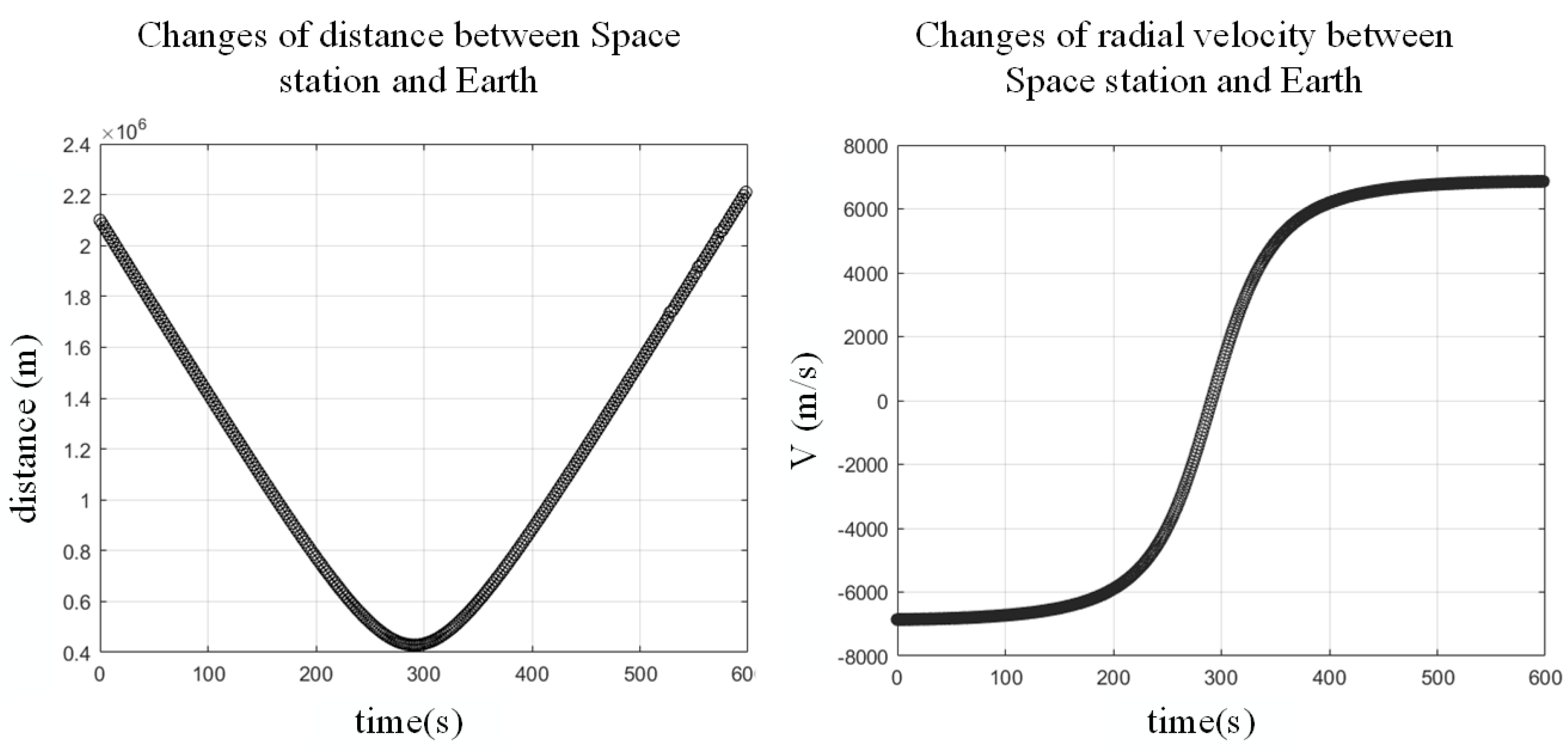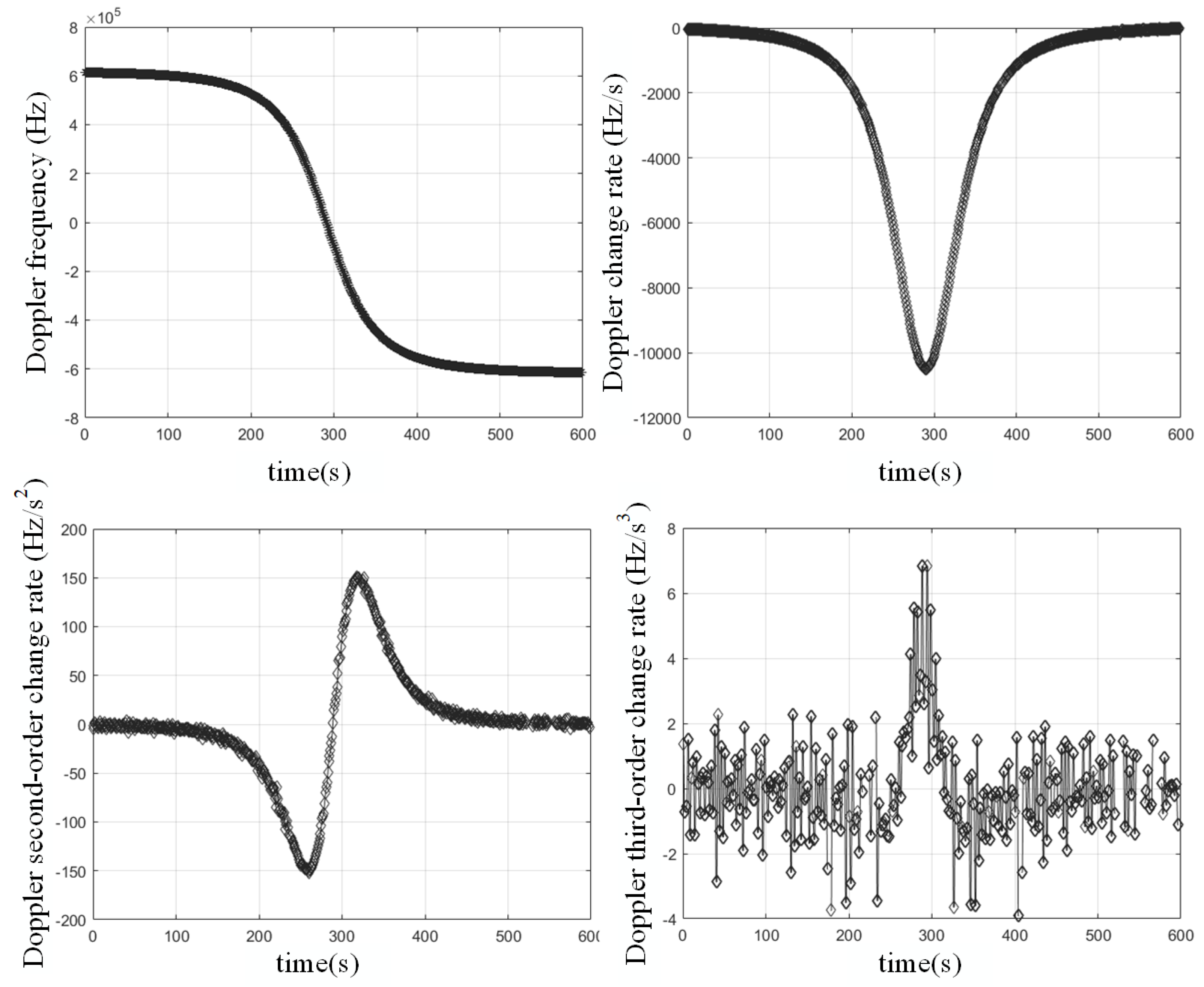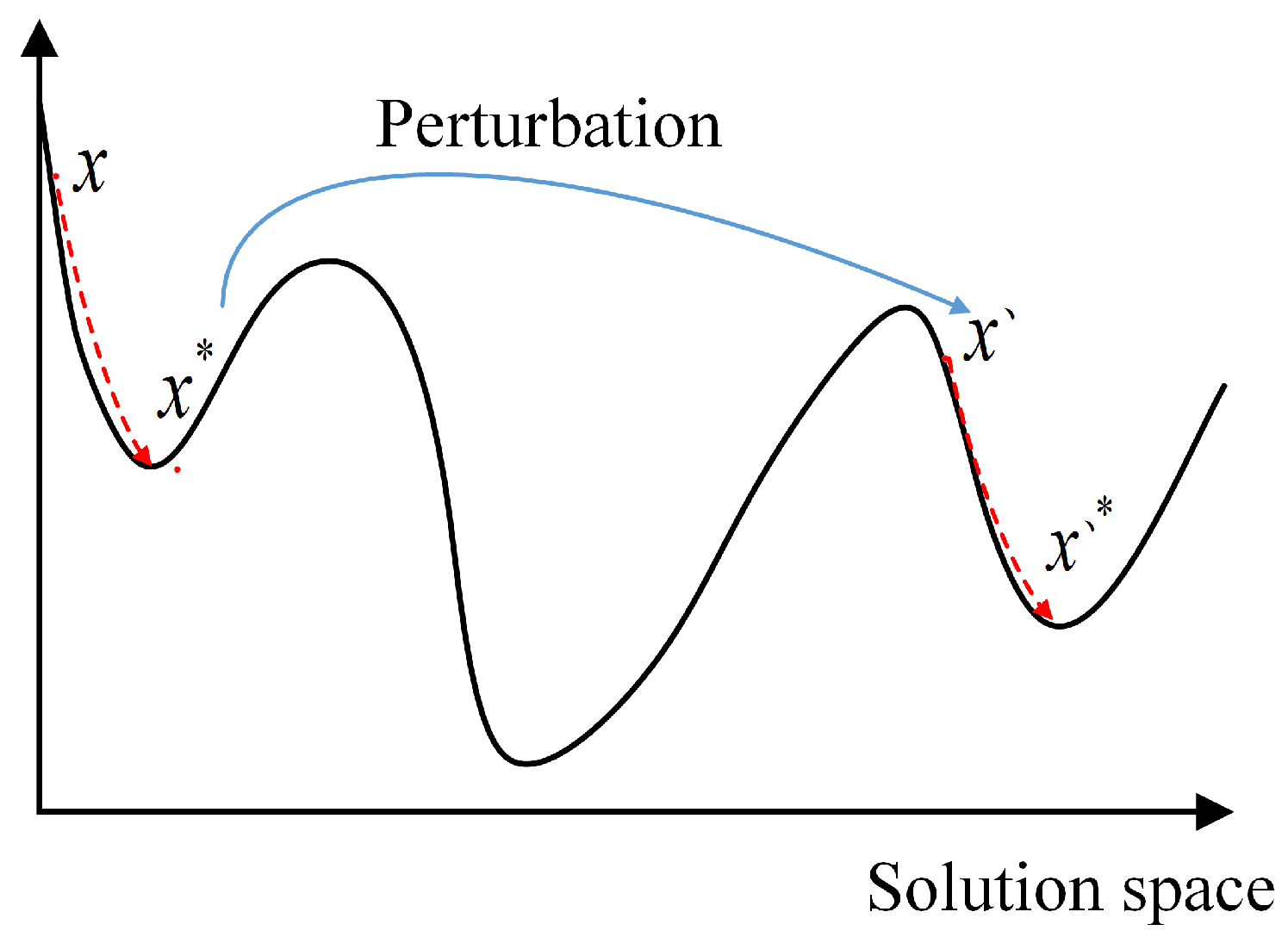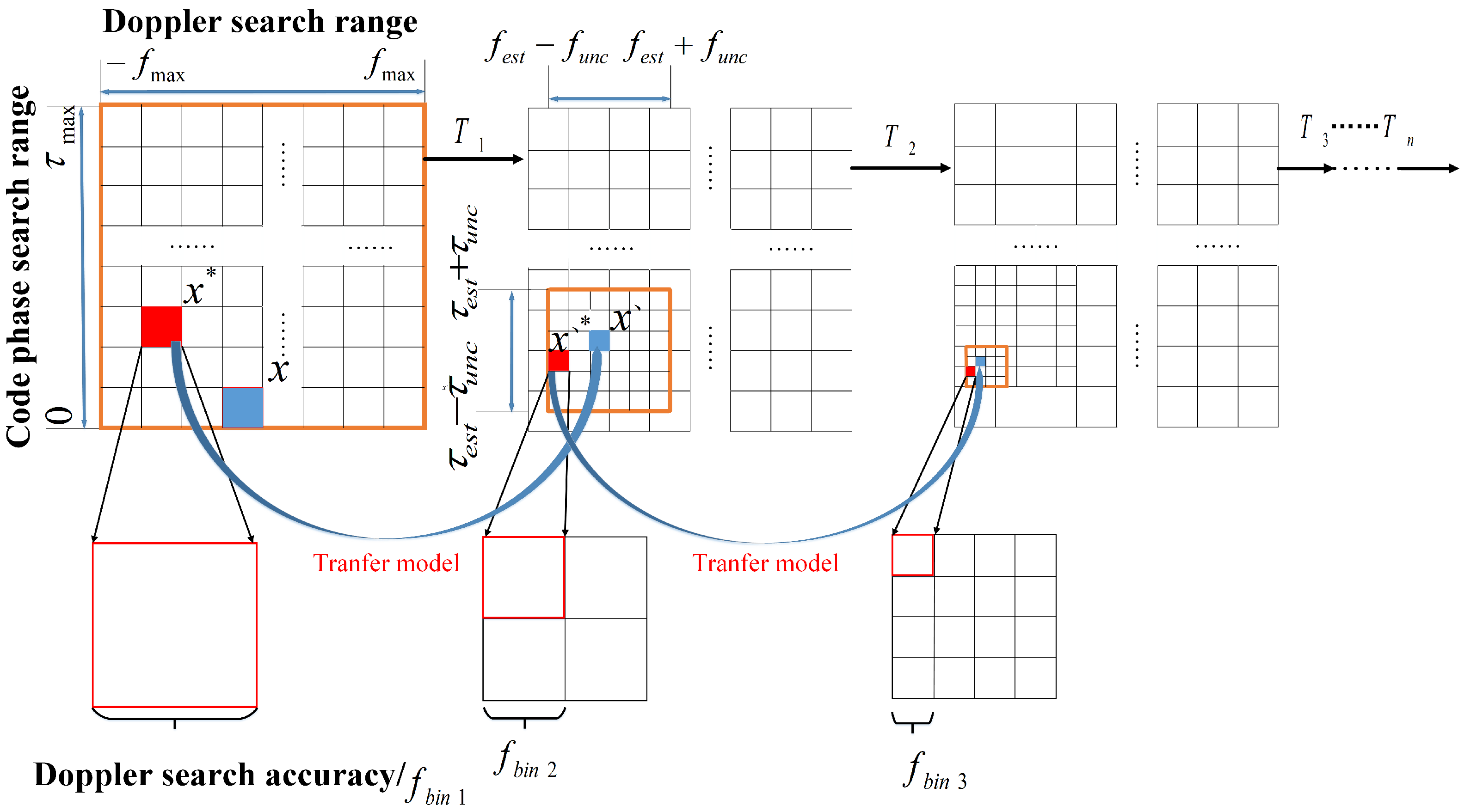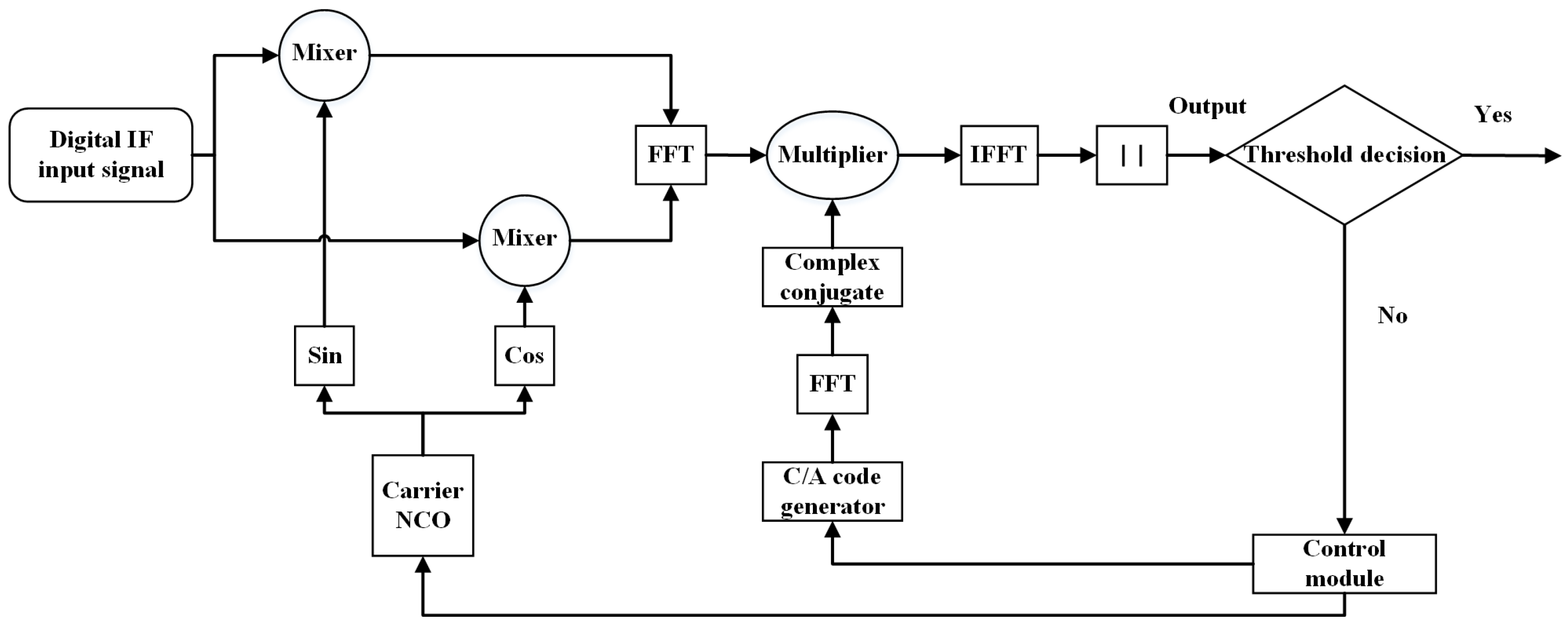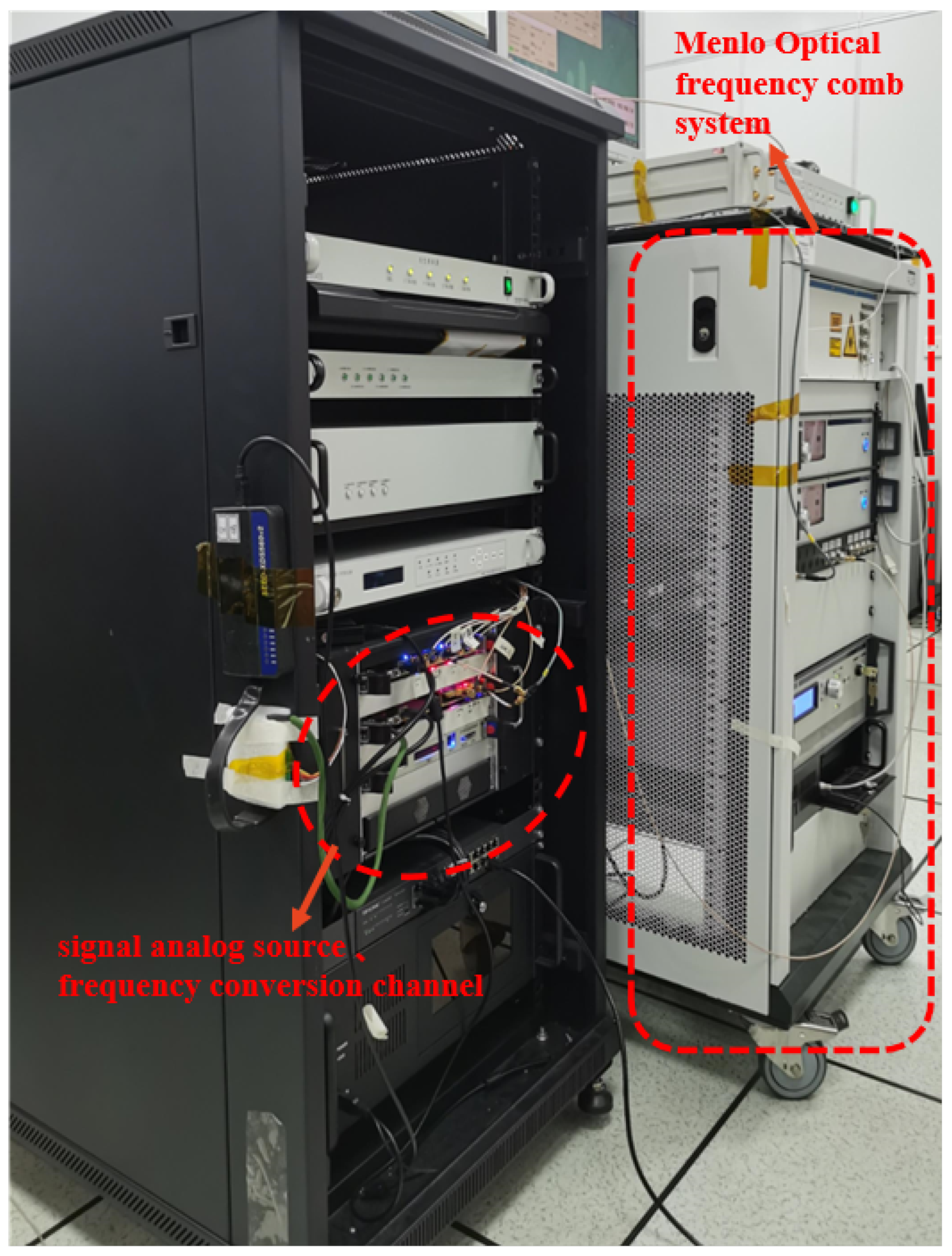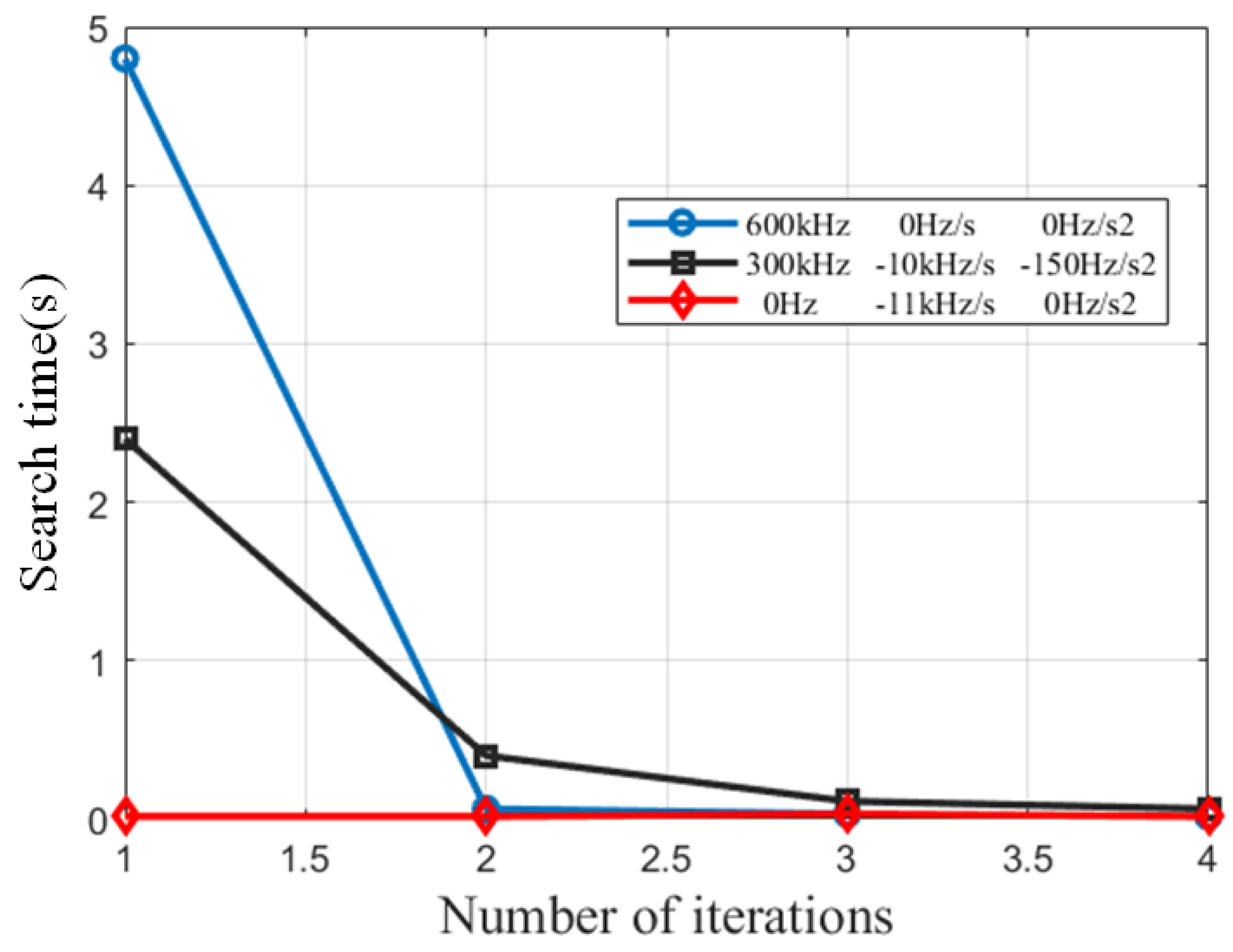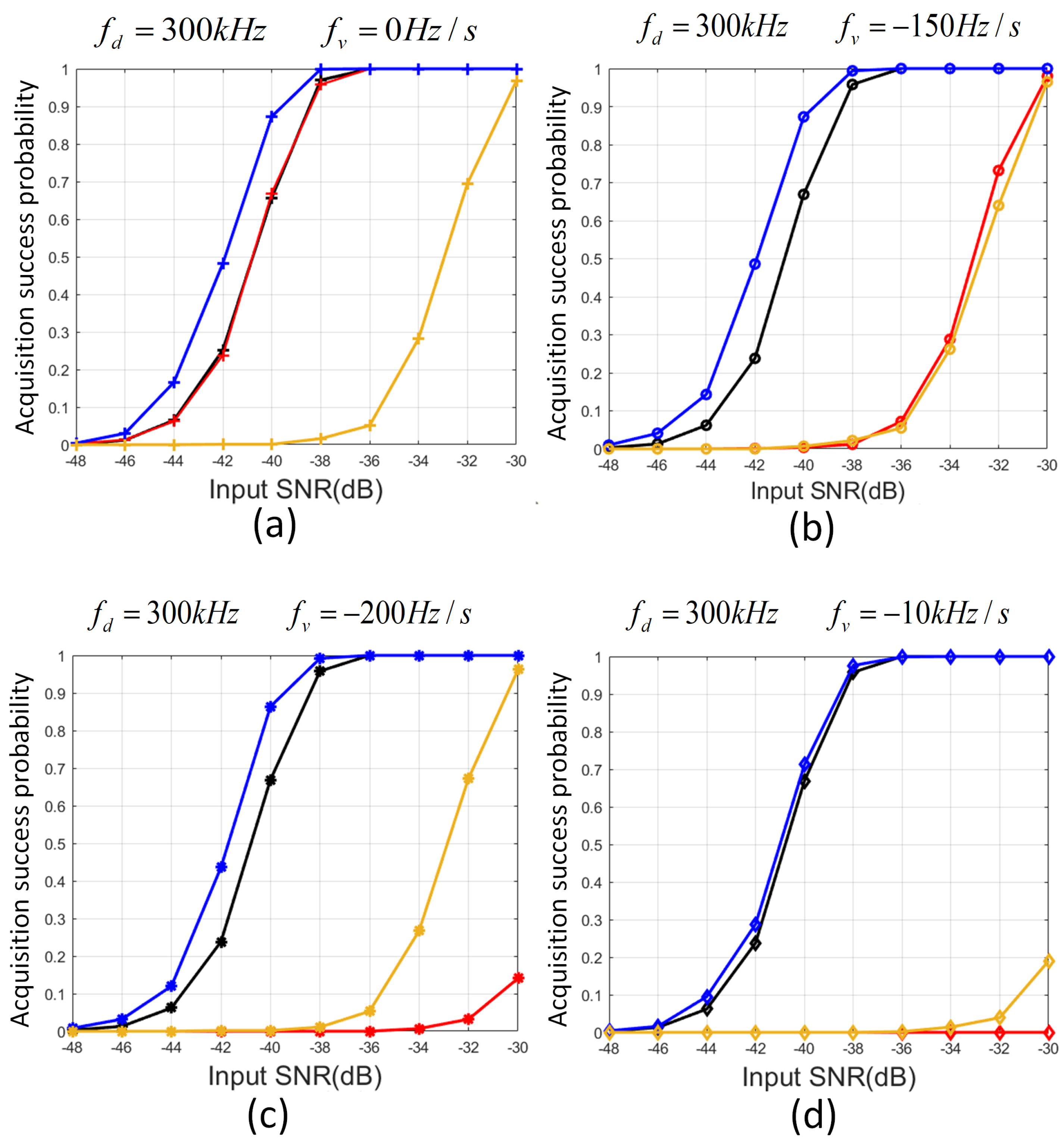1. Introduction
In the development plan of the China Space Station, a set of high-precision time references has been proposed, which is 1–2 orders of magnitude better than the ground time reference. A high-precision time–frequency reference is distributed to the ground and space via a microwave link to compare the time and frequency, and the measurement accuracy of the link is required to be in the picosecond magnitude [
1].
When spread spectrum technology is used to measure the satellite-ground microwave link, stable and reliable acquisition is the premise of link establishment. To satisfy the required high-precision measurement, the project uses a high carrier frequency and a high code rate. Coupled with the low orbital height of the space station, there is often a relatively high-speed radial motion between the signal transmitter and the ground receiver, and the spread spectrum signal has a large frequency offset and is significantly dynamic. Moreover, in the initial entry arc, the space station is in the low elevation side lobe region of the receiving antenna, and the receiving gain is 8–10 dB lower than that of the main lobe, which further inhibits signal acquisition.
Classical acquisition methods of the spread spectrum signal mainly include the linear search method, the parallel frequency search method, and the parallel code phase search method [
2,
3]. The linear search method takes a long time for the acquisition, but the algorithm’s complexity is low. The algorithm complexity of the two methods of parallel search is slightly higher, and the acquisition time is greatly reduced [
4,
5,
6,
7,
8,
9]. However, in a high dynamic environment, when the weak signal is captured, the classical acquisition algorithm still has a large amount of computation.
Considering the challenge of high dynamic weak spread spectrum signal acquisition, numerous studies have been conducted to develop an appropriate algorithm. In [
10], a Partially Matched Filter combined with the FFT (PMF-FFT) algorithm was proposed to realize the rapid search of the Doppler frequency in the received signal. However, in the face of weak signal acquisition, the acquisition time is inordinately long, and real-time acquisition is difficult. In [
11], an acquisition algorithm based on the fractional Fourier transform was proposed to address the Doppler change rate problem of a signal. This approach facilitated the search for the Doppler change rate and the second-order change rate. However, certain problems remain unresolved such as the complexity of the acquisition algorithm and the difficulty of implementation. In [
12], an acquisition strategy was proposed using the ephemeris to address the acquisition of the prior information. The search range in the frequency domain was greatly reduced based on the prior information signal acquisition. However, this strategy relied on the accuracy of the prior information, and the reliability of the acquisition is difficult to ensure.
We propose an acquisition strategy based on ILS, which can improve the sensitivity of a contemporary acquisition algorithm in dynamic environments and enhance its adaptability in high dynamic and low SNR environments by changing the strategy without prior information. In the simulation process, the classical parallel code phase search is used as an example to compare the acquisition performance of the algorithm for high dynamic weak signals before and after changing the strategy.
The rest of this paper is organized as follows.
Section 2 describes the model of the space station ranging signal.
Section 3 introduces the ILS strategy and transfer model, and the computational load of the parallel code phase search algorithm under the ILS strategy is analyzed.
Section 4 verifies the effect of the parallel code phase search algorithm under the ILS strategy on the satellite-ground microwave link signal acquisition of the space station, and the acquisition effect of the parallel code phase algorithm before and after changing the strategy for a high dynamic weak signal is compared.
Section 5 summarizes the experimental results and the advantage of the ILS strategy.
2. Space Station Ranging Signal Model
The China Space Station is in low Earth orbit at an altitude of 400 km to 450 km. It has a high flight speed, and the center frequency of the microwave link ranging signal is in the Ka band with a high frequency [
1]. Owing to the high speed of the space station, the spread spectrum signal not only has a large frequency deviation, but also includes a Doppler rate of change and a high-order rate of change.
According to the number of orbital elements of the space station released on the website of the China Manned Space Engineering Office and using Beijing in WGS-84 coordinates coordinates (−2,172,495 m, 4,389,278 m, 4,072,343 m) as the ground station coordinates, the variation of the distance and radial velocity between the space station and the ground station in the over the top arc segment is shown in
Figure 1. Taking the 26 GHz frequency point in the Ka band as the carrier center frequency, the dynamic situation of the spread spectrum signal is analyzed according to the above flight situation of the space station, according to the equation:
where
is the Doppler frequency of the signal;
is the center carrier frequency;
c is the speed of light (
c = 299,792,458 m/s). Doppler changes can be obtained through higher−order fitting, as shown in
Figure 2.
According to
Figure 2, under the background of the satellite-ground microwave link of the space station, the Doppler change rate above the third order is low, which has little influence on the acquisition and can be neglected. Given that the high-order dynamics over the cubic term of the time variable are negligible, the signal model can be given by:
where
P is the power of the signal;
is the spreading code;
is the initial carrier phase, which is assumed to be 0;
is the Doppler change rate;
is the Doppler second-order rate of change;
is the noise. The coherent integral gain is given by:
where
R is the code auto-correlation function;
is the code phase delay error;
is the coherent integration time;
is the Doppler frequency error;
is the Doppler change rate error;
is the Doppler second-order rate of the change error;
is the noise after correlation. When the coherence integration time is short, the influence of the Doppler change rate and the second-order change rate can be ignored. When the coherence integration time is long, the influence of the Doppler change rate and second-order change rate must be considered. In one spreading code period, the code auto-correlation function is given by [
2]:
where
is the duration of a chip. When
, the correlation value is at most 1; when
, the correlation approaches the lowest value of 0.
In addition, high dynamics will cause not only the carrier Doppler, but also the code Doppler:
where
is the spreading code rate. Given the high dynamic characteristics of the signal, the code phase slip caused by the code Doppler cannot be ignored. The code phase delay error is given by:
where
is the initial code phase delay error.
3. ILS Acquisition Strategy
In the design of the acquisition algorithm, the acquisition of high dynamic signals involves a two-dimensional search in the time and frequency domains in a short time. This results in the limited sensitivity of the acquisition algorithm to weak signals. The acquisition of low SNR signals requires a long integration time to improve the gain, which results in the poor performance of the acquisition algorithm for dynamic signals. Thus, there is a contradiction between high dynamic signal acquisition and weak signal acquisition.
In the acquisition strategy of traditional acquisition algorithms, there is no correlation between each acquisition, which results in the contradiction between that the high dynamic signal and weak signal will not be reduce. We propose ILS to improve the traditional algorithm, and multiple acquisition processes of the algorithm are linked through information transfer to improve its adaptability to high dynamic and low SNR environments.
3.1. Acquisition Strategy Based on ILS
ILS is a strategy that is commonly used in the field of artificial intelligence to solve optimization problems. For many complex problems, the cost of directly solving the optimal solution is too high; ILS selects the next-best solution to find a sub-optimal or approximately optimal solution. ILS is used in many fields: the financial field [
13], signal processing [
14], scheduling problems [
15], graph partitioning problems [
16]. The basic idea is shown in
Figure 3. In this approach, the search starts with an initial solution
x, and the neighbor solution
of the initial solution is generated by the neighborhood action. According to a specific strategy, the best neighbor
is then selected from the neighborhood solution space of the current solution as the initial solution of the next iteration, and the new neighbor solution
is obtained. This process is iterated until a local optimal solution is obtained [
17].
The acquisition of high dynamic weak signals is essentially a process of the parameter estimation of the received spread spectrum signal. Owing to the constraints of a high dynamic and low SNR environment, the resource requirements are too high to perform signal parameter estimation based on only one time acquisition. The strategy utilized in ILS was adopted to improve the traditional algorithm, and each acquisition is mapped to a single search. The general principle is shown in
Figure 4. In the process of acquisition, the zero-valued element in the time and frequency domains is taken as the initial solution
x, based on a wide range of coarse time and frequency domain searches. A set of the code phase and Doppler frequency is obtained as the neighbor solution
. This information is then utilized to obtain the initial solution
of the next iteration, thus narrowing the scope of the two-dimensional search. As the accuracy of the search improves, a set of the code phase and Doppler frequency is obtained for the new neighbor solution
. An iteration process is then repeated until the search area sufficiently converges.
3.2. Doppler Frequency and Code Phase Transfer Model
In the acquisition strategy based on ILS, multiple searches are used to complete the acquisition. Each search in the acquisition process uses the Doppler and code phase information obtained from the previous search to deduce the starting frequency and the starting code phase of the next search and constantly reduces the search’s scope. Thus, the single search time is successively reduced to meet the requirement of real-time acquisition.
Using the ILS strategy in the acquisition process, the
kth iteration search signal state vector is given by:
where
is the Doppler frequency result of the
kth search;
is the estimation of the Doppler change rate of the
kth search, when
,
;
is the estimation result for the second-order change rate of the Doppler frequency of the
kth search, when
,
;
is the result of the code phase search of the
kth search.
In the ILS strategy, the state model of the signal’s Doppler frequency and code phase transfer can be expressed as follows:
where
T is the elapsed time for the
kth search,
is the elapsed time for the
th search,
is the correction of the predicted value for the
kth carrier Doppler frequency search, and
is the correction of the predicted value for the
kth code phase search.
For example, when , in the signal state vector , each variable can be expressed as:
Doppler frequency: ;
Doppler change rate: ;
Doppler second-order change rate: ;
Code phase: .
3.3. ILS Acquisition Strategy Computation
We used the ILS acquisition strategy to improve the parallel code phase acquisition algorithm as an example to expand the analysis. As shown in
Figure 5, in parallel code phase searching, the received signal is first mixed with the local carrier signal to remove the carrier, and an FFT is then performed. Simultaneously, the local pseudo-code sequence is Fourier transformed and conjugated. After the two signals are processed, they are multiplied, and an IFFT is performed. The peak value detection is then used to determine whether the signal is captured.
Completing a frequency band search requires two dot multiplications of real numbers, a complex multiplication, an FFT, and an IFFT. Completing a complex multiplication requires four real multiplications and two real additions; completing an n-point FFT or IFFT requires
real additions and
real multiplications. The computation required to complete a parallel code phase search is as follows [
18]:
Real number addition operands: ;
Real number multiplication operands: , where is the number of points required for one parallel code phase search, where is the sampling rate, and is the coherent integration time of the parallel code phase search.
For the process of the band parallel code phase search, the required amount of calculation is as follows:
Real number addition operands: ;
Real number multiplication operands:
After using ILS to improve the parallel code phase search algorithm, the acquisition process is shown in
Figure 6. The Doppler, code phase, and acquisition time are obtained by the parallel code phase search of the received signal, and then, the above signal parameters are transferred to the next search by the transfer model. In the iteration process, the coherent integration time, the number of non-coherent integrations, and the Doppler frequency search step of the parallel code phase search are changed by the search parameter control module. After completing the preset number of iterations, the final Doppler frequency and code phase are transmitted to the tracking loop.
The computation amount of the ILS strategy is the sum of the computation amount of multiple rounds of parallel code phase searches. The parallel code phase algorithm based on the ILS strategy for N iterative searches’ calculation can be represented as follows:
Real number addition operands: ;
Real number multiplication operands: , where is the number of frequency bands for the ith parallel code phase search.
3.4. Acquisition Success Probability Analysis
The acquisition success probability is an important indicator to measure the acquisition algorithm. Acquisition success means that when the signal parameters (including the Doppler and code phase) captured by the acquisition algorithm are transmitted to the tracking loop, the error with the real signal parameters is within the tolerance range of the tracking loop. On the one hand, successful acquisition requires that the acquired signal parameters are accurate and, on the other hand, that the acquisition time is within the tolerance range.
The tolerance range of the tracking loop to the carrier frequency error depends on the frequency-locked loop. Reference [
2] pointed out that the frequency-locked loop in the classical tracking loop uses Equation (
9) as the frequency discriminator.
where
is the phase difference at
;
is the phase difference at
;
is the angular frequency error; the result of
is the coherent integration time
of the tracking loop. The frequency pull in the range of the tracking loop is
. In addition, there is code phase deviation in the tracking loop
.
Under the background of the satellite-ground microwave link of the space station, when using the traditional parallel code phase search for the acquisition, the SNR of the signal is low and the acquisition time is long. At this time, due to the influence of the high dynamic characteristics of the signal, the signal parameters obtained by the acquisition and the signal parameters received by the tracking loop greatly deviate. Therefore, the acquisition result of the traditional parallel code phase acquisition algorithm cannot be used as the initial value of the tracking loop, and its acquisition success probability is extremely low. The error
between the searched Doppler frequency transmitted to the tracking loop and the actual Doppler signal Doppler frequency can be given by:
where
is the Doppler search accuracy;
T is the acquisition time. According to Equation (
6), the error
between the searched code phase transmitted to the tracking loop and the actual code phase can be given by:
The parallel code phase acquisition with the ILS strategy gradually reduces the acquisition time through multiple rounds of searches, reduces the error between the acquisition result and the signal parameters of the tracking loop, makes the error within the tolerance range of the tracking loop, and greatly improves the acquisition success probability. According to the transfer model shown in Equation (
8), in the iterative local search strategy, when the single search time is sufficiently small, the Doppler change is approximately linear. The range of
can be given by:
where
is the
kth Doppler search accuracy;
is the
th Doppler search accuracy.
T is the elapsed time for the
kth search;
is the elapsed time for the
th search. The range of
can be given by:
When using Monte Carlo experiments to test the acquisition success probability, we considered the acquisition to be successful when the acquisition result satisfies the following conditions:
4. Experiments and Results
Experiments were performed to evaluate the acquisition strategy based on ILS. In a typical tracking loop, the coherence integration time is 1 ms, and the tolerance range of the Doppler frequency error is within ±500 Hz, while the tolerance range of the code phase error is within ±0.5 chip. Based on this premise, the ILS acquisition strategy was implemented to improve the performance of the parallel code phase algorithm for the high dynamic weak spread spectrum signals of the space station, and the acquisition time was evaluated based on the operating frequency of a typical FPGA chip XC7K325TFFG900-2. The simulation compared the computational burden and the sensitivity of the acquisition algorithm under different dynamic conditions before and after the acquisition strategy was changed. In order to verify the superiority of this method by comparison, we carried out experiments on the acquisition strategy based on prior information, which is widely used in practical engineering; this strategy reduces the acquisition difficulty by providing Doppler information to the acquisition algorithm through external devices (inertial navigation system, ephemeris, etc.). The error range of the INS velocity measurement for different grades is 0.1085 m/s–45.09 m/s [
19]; the corresponding Doppler estimation error range in the space station experiment is 8.6 Hz–3.9 kHz. The velocity error of the ephemeris solution is usually less than 0.2 m/s [
20]; the corresponding Doppler estimation error is less than 17.3 Hz.
As shown in
Figure 7, in the experiment, the high dynamic weak spread spectrum signal is transmitted by the Ground Testing System of the microwave link payload of the China Space Station, and the signal is collected by the Radio Frequency (RF) signal collection system (
Figure 8). The superiority of the algorithm was verified by processing the data collected by the computer. The Ground Testing System mainly consists of the Menlo Optical frequency comb system, signal analog source, and frequency conversion channel; the optical frequency comb system provides high-precision time–frequency reference for the signal analog source and frequency conversion channel (
Figure 9).
(1) Experiment of the space station spread spectrum signal acquisition: The ILS strategy was used to improve the parallel code phase search, and the dynamic maximum signal of the space station was simulated and captured.
Table 1 shows the dynamic simulation signal parameters used for the space station, which correspond to the dynamic maximum signal (as shown in
Figure 2, the Doppler second-order change rate is the largest; the Doppler change rate is nearly the largest).
When the parallel code phase search was performed using the iterative local search strategy to capture the signal, the coherent integration time and the number of non-coherent integrations of a single search must be dynamically adjusted to reduce the overall acquisition time and to improve the accuracy of the Doppler search. The parameters of the preset four iterative local searches are shown in
Table 2.
The signal acquisition results are shown in
Figure 10. Owing to the dynamic characteristics of the signal, the Doppler frequency of the four-segment signal varied significantly. As the iterative search progressed, the scope of the Doppler search was gradually narrowed, and the time required for a single search was gradually reduced. Ultimately, the maximum dynamic signal of the space station can be captured within 3 s. The correlation peak was prominent, and the code phase search was accurate. According to Equation (
12), the Doppler frequency deviation for transmission to the tracking loop can be deduced as
; according to Equation (
13), the code phase deviation for transmission to the tracking loop can be deduced as
, which satisfies the tracing loop requirement.
Using the preset iteration parameters, the acquisition time of the improved parallel code phase search algorithm based on the ILS strategy was simulated under different space station ranging dynamic signal conditions, including the maximum Doppler, maximum Doppler change rate, and maximum Doppler second-order change rate of three cases. The simulation results are shown in
Figure 11; as the Doppler increases, the overall acquisition time of the algorithm increases. As the Doppler change rate increases, the convergence rate of the single acquisition time will slow down. However, the search time of a single iteration will still tend to converge ultimately. According to Equation (
12), the Doppler frequency error
transmitted to the tracking loop also converges.
(2) Comparison experiment: In the initial visible arc segment of the space station, the maximum signal Doppler is 600 kHz and the minimum SNR is −34 dB. When the traditional parallel code phase search was used to capture dynamic signals, the step of the Doppler search was less than 500 Hz to meet the requirement of the tracking loop, and the overall integration time of the algorithm was at least 4 ms to satisfy the requirement of weak signal acquisition. Under these conditions, traditional parallel code phase searching requires at least 2400 frequency bands to search fixed 300 kHz Doppler signals. When the integration time of a single acquisition is constant, the phase search of the parallel code using the ILS strategy requires two iterative rounds. The first Doppler search steps 2 kHz and searches 600 frequency bands, and the second Doppler search steps 500 Hz and searches 8 frequency bands. As shown in
Table 3, after the ILS strategy is adopted, the computation amount of the algorithm is reduced by 75%.
A Monte Carlo experiment was performed to test the acquisition probability before and after changing the strategy under different dynamic conditions. Each result was based on 1000 experiments, when the acquisition results satisfy the conditions shown in Equation (
14), the acquisition is judged to be successful, and the number of successful acquisitions n is obtained at the end of the experiment. The acquisition success probability
P can be given by:
In the experiment, in order to satisfy the demand of the tracking loop, which requires
and
, under the condition of the same coherent integration time, the three methods were tested as follows. The integration time of the traditional parallel code phase acquisition algorithm is 4 ms, and the frequency search step is 500 Hz. The coherent integration time of the parallel code phase search based on the prior information assistance strategy is 4 ms, and the Doppler information is provided by the external device; the Doppler error ranges from 8.6 Hz to 3.9 kHz. The ILS improved parallel code phase acquisition algorithm uses the preset parameters in
Table 2.
The experiment results are shown in
Figure 12. When the Doppler change rate is above −200 Hz/s, the traditional parallel code phase acquisition algorithm can hardly achieve a successful acquisition. When the Doppler change rate reaches −10 kHz/s and the SNR is above −36 dB, the acquisition success probability of the ILS improved parallel code phase acquisition algorithm is still above 99.9%. Therefore, the adaptability of the parallel code phase search algorithm improved by the iterative local search strategy to the dynamic is improved obviously. In addition, as shown in
Figure 12, for the acquisition strategy assisted by prior information, its acquisition effect is closely related to the accuracy of the prior information. When the Doppler error provided by the prior information is 50 Hz, the acquisition effect is better. However, when the prior information error is 150 Hz, the acquisition success probability decreases significantly. The ILS acquisition strategy proposed in this paper can obtain more stable acquisition results without relying on the prior information provided by an extra device.
